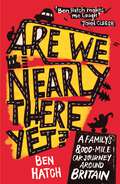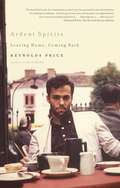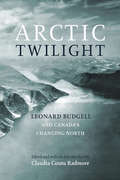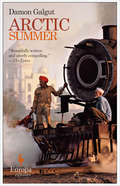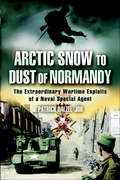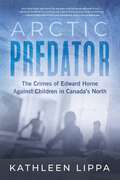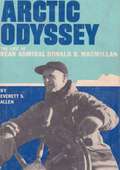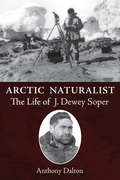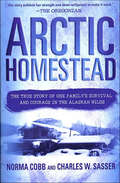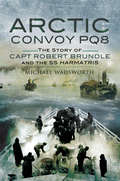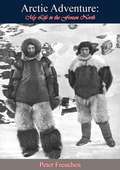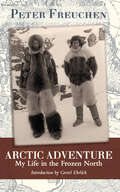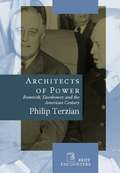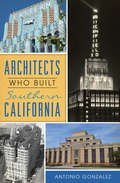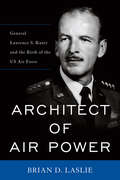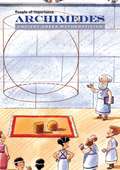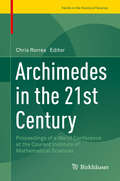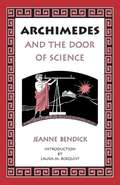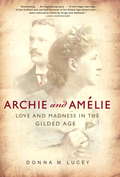- Table View
- List View
Are We There Yet?: To indignity . . . and beyond!
by Emily AtackWarm, charming and remarkably honest - GraziaThe highs, the lows, the hangovers, the relationships, the lucky breaks (and the breaks I worked my arse off for) that have got me to the here and now. Emily Atack was flung to fame at just 17, as Charlotte 'Big Jugs' Hinchcliffe in The Inbetweeners. Nearly ten years later, she won over the nation on I'm a Celebrity . . . Get Me out of Here! thanks to her hilarious impersonations and epic bravery during trials. While she was in the jungle, the country watched her go on a journey of self-acceptance and come out on top. Now Emily reveals the hilarious highs and the heartbreakinglows that rocked the years between. With astonishing courage and her trademark humour, she shares stories about her family, relationships, work life and love.Are We There Yet? is a warm, honest and funny book for anyone who has ever felt the need to break the mould to find out who they really are.
Are We There Yet?: To indignity . . . and beyond!
by Emily AtackWarm, charming and remarkably honest - GraziaThe highs, the lows, the hangovers, the relationships, the lucky breaks (and the breaks I worked my arse off for) that have got me to the here and now. Emily Atack was flung to fame at just 17, as Charlotte 'Big Jugs' Hinchcliffe in The Inbetweeners. Nearly ten years later, she won over the nation on I'm a Celebrity . . . Get Me out of Here! thanks to her hilarious impersonations and epic bravery during trials. While she was in the jungle, the country watched her go on a journey of self-acceptance and come out on top. Now Emily reveals the hilarious highs and the heartbreakinglows that rocked the years between. With astonishing courage and her trademark humour, she shares stories about her family, relationships, work life and love.Are We There Yet? is a warm, honest and funny book for anyone who has ever felt the need to break the mould to find out who they really are.
Are We There Yet?: To Indignity . . . and Beyond!
by Emily Atack"In the underrated noughties film Crossroads, Britney Spears sang the immortal words 'I'm not a girl, not yet a woman'. Cheers Brit. I too find myself getting stuck somewhere between being an overdeveloped teenager and not quite being a fully functioning adult woman. I have no idea how to back-up my iCloud, I can't drive and I'm pretty bad at stopping men with exciting beards and unbuttoned vintage shirts from taking a big old walk all over me. In fact, not a girl, not yet a woman . . . it sums up my twenties perfectly." <p><p>Emily Atack was flung to fame at just 17, as the girl-next-door character in The Inbetweeners. Almost ten years later, she won over the nation on I'm a Celebrity Get Me out of Here with her cracking impersonations, epic bravery in the Bushtucker trials and general positivity. <p><p>Now, in her first book, Emily digs deep and reveals the hilarious highs and the heart-breaking lows that rocked the years between. With astonishing courage and her trade-mark humour, she shares stories about her family, first dates (and bad dates), first loves, moments where she's hit rock bottom and how she finally came to realise that it was all going to be okay. <p><p>Are We There Yet? is a warm, honest, FUNNY book for women of any age who have ever felt they needed to look a certain way or felt uncomfortable in their own skin. It's about life, love, everything grubby and glamorous in between, and ultimately realising that you're good enough. (Also she bought a laptop specifically to write this book so you better believe it's getting down and dirty :D)
Are We Nearly There Yet?: A Family's 8,000-Mile Car Journey Around Britain
by Ben HatchWhen Ben and Dinah saw the advert looking for a husband and wife team with young kids to write a guidebook about family travel around Britain, they jumped at the chance. They embark on a mad-cap five-month trip, embracing the freedom of the open road with a spirit of discovery and an industrial supply of baby wipes.
Are We Nearly There Yet?: A Family's 8,000-Mile Car Journey Around Britain
by Ben HatchWhen Ben and Dinah saw the advert looking for a husband and wife team with young kids to write a guidebook about family travel around Britain, they jumped at the chance. They embark on a mad-cap five-month trip, embracing the freedom of the open road with a spirit of discovery and an industrial supply of baby wipes.
Ardent Spirits
by Reynolds PriceIn his third volume of memoir, Reynolds Price explores six crucial years of his life -- his departure from home in 1955 to spend three years as a student at Oxford University; then his return to North Carolina to begin his long career as a university teacher. He gives often moving, and frequently comic, portraits of his great teachers in England -- such men as Lord David Cecil, Nevill Coghill, and W. H. Auden, who was the most distinguished English-language poet of those years. In London the poet and editor Stephen Spender becomes his first publisher and a generous friend who introduces him to rewarding figures like the essayist Cyril Connolly and George Orwell's encouraging widow, Sonia. He spends rich months traveling in Britain and on the Continent; and above all he undergoes the first loves of his life -- one with an Oxford colleague whom he describes as a "romantic friend" and another with an older man. Back in the States, in his first class at Duke he meets a startlingly gifted student in the sixteen-year-old Anne Tyler; and he soon combines the difficult pleasures of teaching English composition and literature with his own hard delight in learning to write a first novel. At the end of three lonely years, he completes the novel -- A Long and Happy Life -- and returns to England for a fourth year before his novel appears in Britain and America and meets with a success that sets the pace for an ongoing life of fiction, poetry, plays, essays, and translations (Ardent Spirits is his thirty-eighth volume). The droll memories recorded here amount to the unsurpassed -- and, again, often comical -- story of a writer's beginnings; and the young man who emerges has proven his right to stand by his fellows of whatever sex and goal. Ardent Spirits is a book that penetrates deeply into the life of a writer, a teacher, and a steadfast lover.
Ardent Spirits
by Reynolds PriceIn his third volume of memoir, Reynolds Price explores six crucial years of his life -- his departure from home in 1955 to spend three years as a student at Oxford University; then his return to North Carolina to begin his long career as a university teacher. He gives often moving, and frequently comic, portraits of his great teachers in England -- such men as Lord David Cecil, Nevill Coghill, and W. H. Auden, who was the most distinguished English-language poet of those years. In London the poet and editor Stephen Spender becomes his first publisher and a generous friend who introduces him to rewarding figures like the essayist Cyril Connolly and George Orwell's encouraging widow, Sonia. He spends rich months traveling in Britain and on the Continent; and above all he undergoes the first loves of his life -- one with an Oxford colleague whom he describes as a "romantic friend" and another with an older man. Back in the States, in his first class at Duke he meets a startlingly gifted student in the sixteen-year-old Anne Tyler; and he soon combines the difficult pleasures of teaching English composition and literature with his own hard delight in learning to write a first novel. At the end of three lonely years, he completes the novel -- A Long and Happy Life -- and returns to England for a fourth year before his novel appears in Britain and America and meets with a success that sets the pace for an ongoing life of fiction, poetry, plays, essays, and translations (Ardent Spirits is his thirty-eighth volume). The droll memories recorded here amount to the unsurpassed -- and, again, often comical -- story of a writer's beginnings; and the young man who emerges has proven his right to stand by his fellows of whatever sex and goal. Ardent Spirits is a book that penetrates deeply into the life of a writer, a teacher, and a steadfast lover.
Arde la vida: ¿Hasta cuándo vas a tener miedo?
by Magalí TajesArde la vida es una obra transformadora que conquistó el corazón de más de cien mil lectores alrededor del mundo y seguirá haciéndolo. ¿Te animás a ser parte de esta historia? Arde la vida no es un libro, es un incendio. Es un despertar, una búsqueda, una herida abierta en la identidad. Es un golpe en el estómago y el suspiro que sigue a una carcajada infinita. Es un secreto a voces contado al oído de un extraño. ¿Qué disfraz te protege de los otros? ¿Qué soledades te rompieron? ¿Quién va a estar para vos cuando se haga de noche? Arde la vida no es un libro, es un abrazo a tiempo. Es la inocencia perdida, un espejo delator, un refugio en medio de una tempestad. Y abriga. Pero también quema. A cuatro años de su publicación, esta edición actualizada, con nuevos relatos e ilustraciones, te invita a explorar tus emociones más profundas, a perder el miedo, a detener el tiempo y jugar a ser otro, más libre, más suelto, más curioso, menos adulto. Arde la vida es una obra transformadora que conquistó el corazón de más de cien mil lectores alrededor del mundo y seguirá haciéndolo. ¿Te animás a ser parte de esta historia?
Arctic Twilight: Leonard Budgell and Canada's Changing North
by Claudia Coutu Radmore Leonard BudgellLeonard Budgell saw the Canadian North like nobody else. He put his observations into words as few others ever could.As a "Servant of the Bay" Budgell ran Hudson’s Bay Company trading posts for decades in isolated communities up the Labrador coast and across the Arctic. Living among aboriginal Canadians he witnessed episodes and heard stories that would never again be repeated - except he wrote them down. His pen memorably portrays everything from dancing northern lights and hunting practices of birds to astonishing human adventures and predicaments.Northern ways intact for centuries changed with rifles and motorboats, radios and electric generators, new foods and different medicines. Most often, it was Budgell who bridged the aboriginal and southern cultures, building and operating remote radio stations at places like Hebron, taking an RCMP officer into a settlement where a choice had to be made between two different codes of law and behaviour in a murder case. In Arctic Twilight, Budgell chronicles, in an outpouring of letters to a much younger female friend, a traditional way of life that was changing forever.Claudia Coutu Radmore, a teacher, writer, and artist, first met Len Budgell in Winnipeg when she was a fine arts student and he had retired from the Company. Their friendship grew stronger when he began writing remarkable letters after she returned to Queen’s University. Now edited and organized by her, this unique memoir is available to the public for the first time.
Arctic Summer
by Damon GalgutThis &“beautifully written and utterly compelling&” novel by the acclaimed South African author traces E. M. Forester&’s journey of self-discovery (The Times, London). The year is 1912, and the SS Birmingham is approaching India. On board is Edward Morgan Forster, a reserved man taunted by writer&’s block, attempting to come to terms with his art and his homosexuality. During his travels, the novelist confronts his fraught childhood and falls in unrequited love with his closest friend. He also finds himself surprisingly freed to explore his &“minorite&” desires as secretary to a most unusual Maharajah. Slowly, the strands of a story begin to gather in Forster&’s mind: a sense of impending menace, lust in close confines, under a hot, empty sky. But it will be another twelve years and a second stay in India before the publication of his finest work, A Passage to India. Shifting across the landscapes of India, Egypt, and England, Forster&’s life is informed by his relationships—from the Egyptian tram conductor Mohammed el-Adl, to the Greek poet and literary titan C. P. Cavafy. Damon Galgut&’s reimagining of Forster&’s life is a clear and sympathetic psychological probing of one of Britain&’s finest novelists. &“Galgut inhabits [Forster] with such sympathetic completeness, and in prose of such modest excellence that he starts to breathe on the page.&” —Financial Times
Arctic Snow to Dust of Normandy: The Extraordinary Wartime Exploits of a Naval Special Agent
by Patrick Dalzel-JobVery few men have a more exciting and dramatic story of their wartime activities to tell than Patrick Dalzel-Job. In 1940 using his special knowledge of North Norway's coast line he landed and moved over 10,000 Allied soldiers in local boats without the loss of a single life. Acting against specific orders he evacuated civilians from Narvik just before it was bombed—only the King of Norway's intervention halted his court martial. Thereafter his many adventures included spying on enemy shipping and operating behind the lines in France and Germany with Ian Fleming's special force unit '30AU'.
Arctic Predator: The Crimes of Edward Horne Against Children in Canada's North
by Kathleen LippaThe shocking crimes of a trusted teacher wrought lasting damage on Inuit communities in Canada’s Arctic. In the 1970s, a young schoolteacher from British Columbia was becoming the darling of the Northwest Territories education department with his dynamic teaching style. He was learning to speak the local language, Inuktitut, something few outsiders did. He also claimed to be Indigenous — a claim that would later prove to be false. In truth, Edward Horne was a pedophile who sexually abused his male students. From 1971 to 1985 his predations on Inuit boys would disrupt life in the communities where he worked — towns of close-knit families that would suffer the intergenerational trauma created by his abuse. Journalist Kathleen Lippa, after years of research, examines the devastating impact the crimes had on individuals, families, and entire communities. Her compelling work lifts the veil of silence surrounding the Horne story once and for all.
Arctic Odyssey: The Life of Rear Admiral Donald B. MacMillan
by Everett S. AllenIN THESE PAGES, the reader will meet one of America’s foremost seafaring men and explorers. Donald B. MacMillan (1874-1970) was born in Provincetown on Cape Cod and orphaned at an early age. After working his way through Bowdoin College and a brief stint at teaching, he became one of Robert E. Peary’s chief assistants on the arctic expedition that finally fought its way across the bitter Polar Sea to reach the North Pole.There followed a series of arctic expeditions spanning nearly half a century to Labrador, Baffin Island, to King Christian Island, Ellesmere Island and other unknown areas of the Arctic, resulting in valuable work in botany, ornithology, meteorology, and anthropology. He proved that Crocker Land did not exist.The story of the schooner Bowdoin, which for many years visited the North with a crew of scientists and amateurs, is told in detail, as well as the researchers and friendships developed with the Eskimos, in which Miriam MacMillan played a significant part.Arctic Odyssey is the thrilling story of a rich and exciting way of life, centering in the lusty and vigorous personality of one of the last and most colorful representatives of the heroic era of arctic exploration.Everett S. Allen (1916-1990) was an experienced newspaper reporter for The Standard-Times in New Bedford, Massachusetts. For many years he followed the career of Rear Admiral MacMillan and worked closely with him while writing this book.
Arctic Naturalist: The Life of J. Dewey Soper
by Anthony DaltonDewey Soper first travelled to the Arctic in 1923. During the next seven years he accepted three research postings on Baffin Island, each of which lasted between one and two years. In 1929 he discovered the breeding grounds of the blue goose in the southwest corner of Baffin Island. He also charted the final unknown region of Baffin Island’s coastline. Later in life he worked in the western Arctic. Outside the Far North, Soper studied bison in Wood Buffalo National Park, documented bird life on the Prairies, and made a detailed study of small mammals in Alberta. Soper was the last of the great pioneer naturalists in Canada. He was also a skilled and meticulous explorer. As a naturalist, he was a major contributor to the National Museum of Canada, as well as to the University of Alberta and other museums across the country.
Arctic Homestead: The True Story of One Family's Survival and Courage in the Alaskan Wilds
by Charles W. Sasser Norma Cobb“A memoir as wild, engaging, stubborn, and authentic as that distant valley where [Cobb’s] family staked out the last plot in America.” —John Balzar, author of Yukon AloneIn 1973, Norma Cobb, her husband Lester and their five children—the oldest of whom was nine years old and the youngest, twins, barely one—pulled up stakes in the lower 48 and headed north to Alaska to follow a pioneer dream of claiming land under the Homestead Act. The only land available lay north of Fairbanks near the Arctic Circle where grizzlies outnumbered humans twenty to one. In addition to fierce winters and predatory animals, the Alaskan frontier drew the more unsavory elements of society’s fringes. From the beginning, the Cobbs found themselves pitted in a life or death feud with unscrupulous neighbors who would rob from new settlers, attempt to burn them out, shoot them and jump their claim.The Cobbs were chechakos, tenderfeet, in a lost land that consumed even toughened settlers. Everything, including their “civilized” past, conspired to defeat them. They constructed a cabin—and first snow collapsed the roof. They built too near the creek and spring breakup threatened to flood them out. Bears prowled the nearby woods, stalking the children and Lester Cobb would leave for months at a time in search of work.But through it all, they survived on the strength of Norma Cobb—a woman whose love for her family knew no bounds and whose courage in the face of mortal danger is an inspiration to us all. Arctic Homestead is her story.“Her story exhibits her strength and sheer willpower to make it work.” —Oregonian
Arctic Convoy PQ8: The Story of Capt Robert Brundle and the SS Harmatris
by Michael WadsworthWhen Robert Brundle took the SS Harmatris to Russia with Convoy PQ8 he was 47 years of age. Both ship and master were veterans and had already sailed in convoys across the North Atlantic and to South Africa. The 5,395 ton coal fired ship, laden with 8,000 tons of armaments originally set sail on 27 November 1941 to join convoy PQ6 but encountered a fierce storm in which a lorry broke free in the hold and started a fierce blaze below decks. Despite valiant attempts to extinguish the fire the Harmatris was forced to return to Glasgow for repair. Having discharged its cargo, examined and repaired the holds, it restowed and finally put to sea again on 26 December. She was now to join PQ8 and Brundle was elected Convoy Commodore. Two minesweepers, a cruiser and two destroyers escorted the eight merchant vessels.On 8 January the convoy left Reykjavik bound for Murmansk. Harmatris was struck by two torpedoes in No 1 hold which caused flooding. A third torpedo struck her a few hours later and the crew evacuated to HMS Speedwell in attendance. A volunteer crew reboarded and Speedwell took the wounded ship in tow. During the night the same U Boat that had struck Harmatris sunk the destroyer Matabele with the loss of all but two of her crew. A tug eventually replaced Speedwell and the entire crew now returned to their still stricken vessel. On 18 January the ships were twice attacked by low flying Heinkels. The stricken Harmatris finally berthed in Murmansk at 0800 on 20 January. Once unloaded the battered ship entered dry dock on 10 February. The damage was considerable. In a temperature of 40 degrees below zero the crew set about the repairs. It was difficult to locate engine parts and local labor was scarce.During the following months the crew continued to work on the ship, food was scarce and the port was frequently bombed by the Luftwaffe. Several ships close to Harmatris were sunk. It was 21 July when the ship finally left for Archangel. She took aboard a cargo of 3,000 tons of steel pipes and on 13 September she was instructed to join a convoy of 20 ships, QP14 for her return voyage. On 19 September the minesweeper HMS Leda, steaming close by Harmartris, was torpedoed. The convoy was under almost continuous U Boat attack and suffered six losses. As a result of his heroic efforts to preserve his ship and crew Captain Brundle was awarded the OBE and the Lloyds War Medal. He died in 1960 at the age of 66.
Arctic Adventure: My Life in the Frozen North (Lyons Press Series)
by Peter FreuchenOriginally published in 1956, this book is a memoir by Danish explorer Peter Freuchen, a close friend and travel companion of Arctic legend Knud Rasmussen, and ended up living in Greenland for fifteen years, 800 miles from the North Pole--adopting the native ways of life, marrying an Inuit woman, and having two children along the way.Arctic Adventure is filled with tales of seal and polar bear hunts, enduring starvation, encountering people who had resorted to cannibalism, and the stirring experience of seeing the sun again after three months of winter darkness.Rich in human saga, Freuchen's warmth, wit, and literary talent make this recollection of real-life adventure stories a stand-out."Except for Richard E. Byrd, and despite his foreign beginnings, Freuchen was perhaps better known to more people in the United States than any other explorer of our time."--Evelyn Stefansson, The New York Times"[A] formidable and fascinating man"--Harriet Baker, AnOtherRichly illustrated throughout with maps and black-and-white photographs.
Arctic Adventure: My Life in the Frozen North
by Peter FreuchenShortly after his death in 1957, The New York Times obituary of Peter Freuchen noted that "except for Richard E. Byrd, and despite his foreign beginnings, Freuchen was perhaps better known to more people in the United States than any other explorer of our time." During his lifetime Freuchen's remarkable adventures, related in his books, magazine articles, and films, made him a legend. In 1910, Freuchen and his friend and business partner, Knud Rasmussen, the renowned polar explorer, founded Thule-a Greenland Inuit trading post and village only 800 miles from the North Pole. Freuchen lived in Thule for fifteen years, adopting ways of its natives. He married an Inuit woman, and together they had two children. Freuchen went on many expeditions, quite a few of which he barely survived, suffering frostbite, snow blindness, and starvation. Near the North Pole there is no such thing as an easy and safe outing. In Arctic Adventure Freuchen writes of polar bear hunts, of meeting Eskimos who had resorted to cannibalism during a severe famine, and of the thrill of seeing the sun after three months of winter darkness. Trained as a journalist before he headed north, Freuchen is a fine writer and great storyteller (he won an Oscar for his feature film script of Eskimo). He writes about the Inuit with genuine respect and affection, describing their stoicism amidst hardship, their spiritual beliefs, their ingenious methods of surviving their harsh environment, their humor and joy in the face of danger and difficulties, and the social politics behind such customs as "wife-trading." While his experiences make this book a pageturner, Freuchen's warmth, self-deprecating wit, writing skill and anthropological observations make this book a literary stand out.
Architects of Power
by Philip TerzianThe United States is not a preternaturally inward-looking nation, and isolation is not the natural disposition of Americans. The real question is not whether Americans are prone to isolation or engagement, but how their engagement with the world has evolved, how events have made the United States a superpower, and how these developments have been guided by political leadership. Indeed, the great debates on foreign affairs in American history have not been about whether to have debates on foreign affairs; they have been between the competing visions of American influence in the world.In Architects of Power, Philip Terzian examines two public figures in the twentieth century who personify, in their lives, careers, and philosophies, the rise of the United States of America to global leadership: Franklin D. Roosevelt and Dwight D. Eisenhower. Terzian reveals how both men recognized and acted on the global threats of their time and questions whether America can rise to the same challenges today. Without this clear window into the stricken world that Roosevelt inhabited and Eisenhower understood, we are unlikely to recognize the perils and challenges of the world we have inherited.
Architects Who Built Southern California
by Antonio GonzalezIn the early 1900s, the population of Southern California exploded, and the cities grew at such a rapid pace that builders could hardly keep up. Among those who settled in the area were ten architects looking to make their marks on the world. Claud Beelman, a man who never received a college degree, would go on to design the Elks Lodge in Los Angeles. Albert C. Martin, architect of Grauman's Million Dollar Theater, founded a company that is still going strong more than one hundred years later, and Julia Morgan, the first woman architect licensed in California, was hired by William Randolph Hearst to design the Examiner Building. Join author Antonio Gonzalez as he tells the stories of the people behind some of Southern California's most iconic buildings.
Architect of Air Power: General Laurence S. Kuter and the Birth of the US Air Force (American Warriors Series)
by Brian D. LaslieA biography of the pioneering four-star general, chronicling his influence on the United States Air Force.At age 36, Laurence S. Kuter (1905–1979) became the youngest general officer since William T. Sherman. He served as deputy commander of allied tactical air forces in North Africa during World War II and helped devise the American bombing strategy in Europe. Although his combat contributions were less notable than other commanders in the Eighth Air Force, few officers saw as many theaters of operation as he did or were as highly sought-after. After World War II, he led the Military Air Transport Service, Air University, Far East Air Forces, and served as commander-in-chief of the North American Air Defense Command (NORAD). Despite these accomplishments and others, however, Kuter remains widely underappreciated.In Architect of Air Power, Brian D. Laslie offers the first biography of this important but unsung pioneer whose influence can be found in every stage of the development of an independent US Air Force. From his early years at West Point to his days at the Air Corps Tactical School to his leadership role at NORAD, Kuter made his mark with quiet efficiency. He was an early advocate of strategic bombardment rather than pursuit or fighter aviation?fundamentally changing the way air power was used?and later helped implement the Berlin airlift in 1948. In what would become a significant moment in military history, he wrote Field Manual 100-20, which is considered the Air Force’s “declaration of independence” from the Army.Drawing on diaries, letters, and scrapbooks, Laslie offers a complete portrait of this influential soldier. Architect of Air Power illuminates Kuter’s pivotal contributions and offers new insights into critical military policy and decision-making during the Second World War and the Cold War.Praise for Architect of Air Power“Laslie expertly brings into focus perhaps the least known of the major Air Force personalities of World War II and the early Cold War. Kuter was the indispensable “behind-the-scenes” man in those years, and this book fills a similarly indispensable gap in our understanding of the people and ideas that propelled the nation’s air arm to independence and prominence.” —Thomas Alexander Hughes, author of Over Lord: General Pete Quesada and the Triumph of Tactical Air Power in World War II“Laslie’s outstanding work on Laurence Kuter is the first full and highly effective look at this exceptionally important airman. It gives the reader ample evidence of Kuter’s central role in making America the quintessential airpower nation during the course of the twentieth century. This will be the book on Kuter for many years to come.” —Robert S. Ehlers, Jr., author of The Mediterranean Air War: Airpower and Allied Victory in World War II
Archimedes: Ancient Greek Mathematician
by Susan KeatingModern life would be very different without the ideas of brilliant Greek scholar Archimedes. From the simple lever to complicated machines, his work in mathematics, physics, engineering, and astronomy helped to shape the world we live in today. Few thinkers of any time period have had as big an impact on math and science as the genius Archimedes. Learn the story of one of the most important mathematic thinkers of all time in Archimedes: Ancient Greek Mathematician.
Archimedes in the 21st Century: Proceedings of a World Conference at the Courant Institute of Mathematical Sciences (Trends in the History of Science)
by Chris RorresThis book is a collection of papers presented at the "Archimedes in the 21st Century" world conference, held at the Courant Institute of Mathematical Sciences in 2013. This conference focused on the enduring and continuing influence of Archimedes in our modern world, celebrating his centuries of influence on mathematics, science, and engineering. Archimedes planted the seeds for a myriad of seminal ideas that would grow over the ages. Each chapter surveys the growth of one or more of these seeds, and the fruit that they continue to bear to this day. The conference speakers contributing to this book are actively involved in STEM fields whose origins trace back to Archimedes, many of whom have conducted and published research that extends Archimedes' work into the 21st century. The speakers are not historians, so while historical context is provided, this book is uniquely focused on the works themselves as opposed to their history. The breadth and depth of Archimedes' influence will inspire, delight, and even surprise readers from a variety of fields and interests including historians, mathematicians, scientists, and engineers. Only a modest background in math is required to read this book, making it accessible to curious readers of all ages.
Archimedes and the Door of Science
by Jeanne BendickJeanne Bendick, through text and pictures, admirably succeeds in bringing to life the ancient Greek mathematician who enriched mathematics and all branches of science. Against the backdrop of Archimedes' life and culture, the author discusses the man's work, his discoveries and the knowledge later based upon it. The simple, often humorous, illustrations and diagrams greatly enhance the text.
Archie and Amelie: Love and Madness in the Gilded Age
by Donna M. LuceyFilled with glamour, mystery, and madness, Archie and Amélie is the true story chronicling a tumultuous love affair in the Gilded Age. John Armstrong "Archie" Chanler was an heir to the Astor fortune, an eccentric, dashing, and handsome millionaire. Amélie Rives, Southern belle and the goddaughter of Robert E. Lee, was a daring author, a stunning temptress, and a woman ahead of her time. Archie and Amélie seemed made for each other—both were passionate, intense, and driven by emotion—but the very things that brought them together would soon tear them apart. Their marriage began with a “secret” wedding that found its way onto the front page of the New York Times, to the dismay of Archie’s relatives and Amélie’s many gentleman friends. To the world, the couple appeared charmed, rich, and famous; they moved in social circles that included Oscar Wilde, Teddy Roosevelt, and Stanford White. But although their love was undeniable, they tormented each other, and their private life was troubled from the start. They were the F. Scott and Zelda Fitzgerald of their day—a celebrated couple too dramatic and unconventional to last—but their tumultuous story has largely been forgotten. Now, Donna M. Lucey vividly brings to life these extraordinary lovers and their sweeping, tragic romance. “In the Virginia hunt country just outside of Charlottesville, where I live, the older people still tell stories of a strange couple who died some two generations ago. The stories involve ghosts, the mysterious burning of a church, a murder at a millionaire’s house, a sensational lunacy trial, and a beautiful, scantily clad young woman prowling her gardens at night as if she were searching for something or someone—or trying to walk off the effects of the morphine that was deranging her. I was inclined to dismiss all of this as tall tales Virginians love to spin out; but when I looked into these yarns I found proof that they were true. . . .” —Donna M. Lucey on Archie and Amélie


